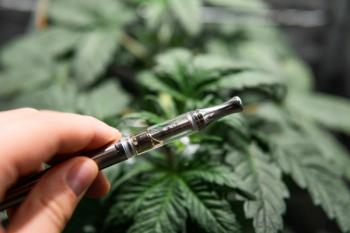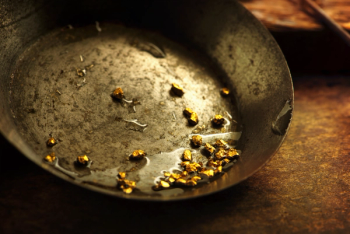
Countercurrent Chromatography Developments for the Cannabis Industry

Dr. Les Brown, Managing Director of AECS-QuikPrep Ltd., recently spoke to us about the benefits of countercurrent chromatography (CCC) compared to other methods as well as the work his company has been doing to advance the technique for their clients in the cannabis industry.
There are many chromatography-based techniques being used and discussed in the cannabis industry, but one technique that deserves a bit more focus as it moves into the forefront of laboratories is countercurrent chromatography (CCC). CCC is a type of liquid–liquid chromatography that uses a liquid stationary phase held in place by centrifugal force and is used to separate, identify, and quantify the chemical components of a mixture, such as cannabis. Dr. Les Brown, Managing Director of AECS-QuikPrep Ltd., recently spoke to us about the benefits of CCC compared to other methods as well as the work his company has been doing to advance the technique for their clients in the cannabis industry.
Please tell us about countercurrent chromatography (CCC) and how it is being used in the cannabis industry.
Dr. Les Brown: My company has specialized in cannabinoid purifications for more than 10 years by liquid–liquid chromatography (hydrodynamic CCC and hydrostatic CCC, also referred to as centrifugal partition chromatography [CPC]). We have been contracted for several cannabinoid research contracts, with subsequent instrument purchases. We have trained client staff during our instrument installations for cannabinoid purifications, at both research and process scale operations.
The main interests are:
- Removal of tetrahydrocannabinol (THC) to below 0.3% in broad spectrum hemp extracts.
- Removal of state defined contaminants from process scale purifications of THC, cannabidiol (CBD), and so forth.
- Research into alternative biphasic solvents systems that do not use alkanes.
- Identifying and purifying trace medicinal cannabinoids to assist novel human and animal medicine developments.
What advantages does CCC offer compared to other chromatography methods, such as high-performance liquid chromatography (HPLC)?
Brown: There are several advantages, such as:
- No on-column absorption or degradation or infinite retention, with generally 95% to 99%+ mass balance, for mass injected to mass recovered.
- No expensive stationary phase to buy, no column packing facilities required, and no solid phase disposal issues.
- Reduction of solvent use for same mass of product. Reductions can vary, but generally 1/2 to 1/5 of solvent may be used compared to HPLC. Greater savings are achievable if comparing to flash chromatography
- The same instrument can prepare infinitely polar or infinitely nonpolar compounds merely by changing the biphasic solvent choice
What challenges are faced in designing a CCC solvent system for a specific separation, such as medicinal cannabinoids?
Brown: If one understands basic chemistry principles, the implications of solvency, density, surface tension, emulsifying agents to biphasic systems, plus compound and target compound functionality, the Synder polarity triangle, and so on, and can shake solvents in a 10 mL stopper measuring cylinder to define partition coefficient in upper and lower phase, then biphasic solvent choice is extremely intuitive.
It is a shame that nonchemists insist on a “witches brew” approach of set ratios, which has held CCC and CPC back for decades.
We have been developing the use of ionic liquids in CCC and CPC for eight years. Ionic liquids offer amazing alternatives. I believe the future for cannabinoids, monoclonal antibodies (mAbs), proteins, pharmaceuticals, petrochemicals, precious metals, lanthanides, and actinides will ultimately be two solvent ionic liquid based biphasic solvent systems for large scale process. This will ease one of the cost elements in all liquid–liquid chromatography and extraction uses (namely, eluent recycling).
Can you tell us about the specific instrument you designed for medicinal cannabinoids?
Brown: The Quattro PilotPrep CPC with both method development rotors and process rotors is the same instrument that was recently designed and built for a U.S. hemp cannabinoid production and research company. The client desired a single instrument that could do method development and could also be utilized for 24/7 kilo+ per day production. This instrument had to be able to be used in standard laboratory, non ATEX 1 (Appareils destinés à être utilisés en Atmosphères Explosibles) environments. The unique design contains a 4.2 L process CPC rotor assembly and a 360 mL method development rotor assembly. We have also developed an ancillary instrument package of 2 x 300 mL/min HPLC, quaternary gradient pumps, manual and process injection, ultraviolet-visible (UV-vis) scanning detection, choice of prep HPLC or CPC switching, laboratory and process fraction collection, plus electric switching of ascending or descending choice. The whole system is computer controlled, and inclusive of all valve operations. We hope shortly to evolve this system to premix each of the biphasic layers required for CPC eluent production using the above. This would save considerable time and effort needing to premix very large volumes of CPC or CCC biphasic eluents.
The ATEX 1, Partitron CPC has recently been upgraded for multiple ton per annum medicinal process production. This instrument package is inclusive of ATEX 1 ancillaries and is also fully computer controlled.
What kind of support do you offer clients after they purchase instruments? Why do you think that is an important aspect of the cannabis industry?
Brown: We believe it is essential that clients receive expert installation and training. The price of our equipment includes one-week installation and training on the client’s own extracts. We also offer the option to extend this training, as mutually agreed, between the client and ourselves.
We will also conduct research in the client laboratories, so their staff can have first hand experience of method development procedures. We have run such courses since early 2000 in countries as varied as Brazil, Canada, China, Australia, and various European countries. Within the next four months, we will run courses for medicinal cannabinoids in client laboratories in the U.S. and Canada and for noncannabinoid, fundamental ionic liquid CPC research in Brazil.
What are your next steps in developing cannabis-specific instruments?
Brown: We are collaborating on three main aspects. Firstly, scale-up to multiple 100s of liters CPC capacity to allow the throughput of multiple tons per year, that clients are requesting for medicinal cannabinoid production. Secondly, we are collaborating on various approaches to recycle CCC or CPC biphasic solvents economically, to enhance the 24/7 operation of CCC or CPC. Thirdly, we are researching if our 2 x 300 mL/min quaternary pumping system can routinely be used in coresearching client laboratories, routinely mix a variety of biphasic eluents, as well as performing crude matrix injections in the running biphasic eluent.
Newsletter
Unlock the latest breakthroughs in cannabis science—subscribe now to get expert insights, research, and industry updates delivered to your inbox.


